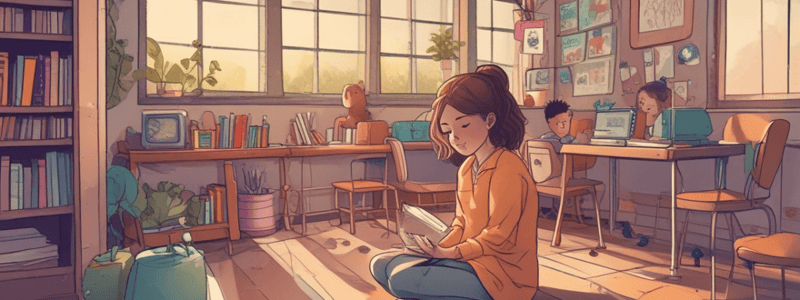Podcast
Questions and Answers
What is the primary purpose of creating a calming area for young children?
What is the primary purpose of creating a calming area for young children?
Which of the following is an example of a visual calming tool?
Which of the following is an example of a visual calming tool?
What is the purpose of noise-cancelling headphones in a calming area?
What is the purpose of noise-cancelling headphones in a calming area?
Why is it important to ask children if they want to use the calming area?
Why is it important to ask children if they want to use the calming area?
Signup and view all the answers
What is an example of a mindfulness activity that can be included in a calming area?
What is an example of a mindfulness activity that can be included in a calming area?
Signup and view all the answers
What is the benefit of including tactile toys in a calming area?
What is the benefit of including tactile toys in a calming area?
Signup and view all the answers
What is the purpose of a sound machine in a calming area?
What is the purpose of a sound machine in a calming area?
Signup and view all the answers
What is the benefit of including proprioceptive input tools in a calming area?
What is the benefit of including proprioceptive input tools in a calming area?
Signup and view all the answers
Study Notes
Creating a Calming Area for Young Children
Visual Calm
- Use soft lighting, such as lamps or string lights, to create a soothing atmosphere
- Hang calming images, like peaceful nature landscapes, lava lamps, or aquariums, to create a visually calming environment
Auditory Relief
- Use a sound machine that can play white noise or natural sounds, like rain or ocean waves
- Provide a playlist of soft, soothing music for children to choose from
- Offer noise-cancelling headphones to block out external noises and create a quiet space
Tactic Engagement
- Provide stress balls or fidget toys for children to squeeze or manipulate
- Use textured mats or rugs with different textures for children to touch and sit on
- Offer weighted blankets or stuffed animals to provide comfort and a sense of security through their weight
Mindfulness Activities
- Provide guided imagery recordings or scripts to help children relax
- Use breathing exercise cards to illustrate simple breathing techniques
- Offer mindfulness coloring books with intricate patterns for meditative coloring
Proprioceptive Input
- Use bean bag chairs or pillows to provide deep pressure for comfort
- Incorporate balance beams to help children engage their muscles and focus their energy
- Offer therapy putty or Play-Doh to help with hand strength and provide a satisfying sensory experience
General Tips
- Create a multisensory environment that meets individual needs and preferences
- Use the calming area as a tool, rather than a form of punishment or time-out
- Ask the child if they would like to use the calming area or join you there
Studying That Suits You
Use AI to generate personalized quizzes and flashcards to suit your learning preferences.
Description
Learn how to create a calming area for young children, incorporating visual and auditory elements to promote relaxation and serenity. Discover the importance of soft lighting, calming images, and soothing sounds in creating a peaceful atmosphere.




